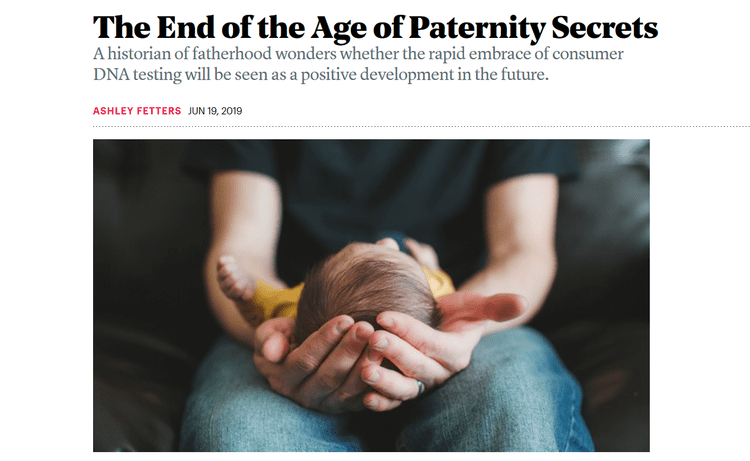


06/21/2019
From The Atlantic:
The End of the Age of Paternity Secrets
A historian of fatherhood wonders whether the rapid embrace of consumer DNA testing will be seen as a positive development in the future.
ASHLEY FETTERS
1:19 PM ETWhen Nara Milanich wrote Paternity: The Elusive Quest for the Father — a history of the scientific, legal, and social conceptions of fatherhood in Western civilization — she wasn’t expecting that her publicity tour would be full of interviewers asking her whether she’s done 23andMe. And, truth be told, she’s not that into the question. …
Paternity traces the long history of how society got here, to a place where biological paternity is a patently knowable fact that’s apparently fair game to ask a stranger about. As Milanich explains in the book, certainty of biological paternity is a relatively new concept in the long arc of human history.
Less so than the reviewer imagines.
Though it’s been known for centuries that every person has one biological father, the notion that this biological father could be determined by science first broke through in the early 20th century. Milanich’s book illustrates in detail how paternity testing became both a useful tool and a powerful weapon, depending on whose hands the technology landed in. …
An amusing restatement of today’s dominant “Who? Whom?” paradigm.
Maternity, Milanich notes early on in the book, tends to be a much less mysterious relationship than paternity, given the visible facts of pregnancy and birth.
True, but Queens of France were required to have VIP witnesses crowd into the royal bedroom to watch the birth of an heir to the throne. This was to prevent rumors that the would-be heir had been stillborn and a baby commandeered from somebody else had been substituted.
Historical novels about royalty are full of all sorts of variations on these themes, such as illegitimate children, impostors, and so forth and son.
Paternity, by contrast, is invisible, and until the 20th century and the advent of the earliest paternity testing, claims to fatherhood (and denials of fatherhood) were only as strong as the implicated parties’ insistence, and circumstantial evidence.
As a result, Milanich explains, for most of modern history, neither the public nor the courts made any distinction between legal and biological fatherhood.
Ehhhh … My impression is that the public gossiped endlessly about such matters, although the law would often try to impose some presumptions to make it less uncertain who would inherit.
When someone had a father, it was because a man had claimed fatherhood status and behaved as a father was expected to by providing care and shelter.
The husband of a wife was generally understood, by society and by most countries’ laws, to be the father of her children and thus responsible for providing for them — a rule that proved frustrating to some men when suspicions about their wife’s marital fidelity arose.
Okay, but other people have an interest in predictable inheritances, such as merchants selling to rich men’s heirs on credit.
The expectation for a husband to also necessarily be a father is why the notion of “stepchildren” didn’t really break into mainstream consciousness until the 20th century.
Not exactly … countless spouses died and the surviving parent remarried: see Hamlet, for example.
The fascination with knowing paternal identity tends to be a strong and propulsive one. The once-murky nature of paternity provides the central tension of countless great works of fiction, for example. Even contemporary works such as Min Jin Lee’s National Book Award–nominated Pachinko and Elena Ferrante’s bestselling Neapolitan novels, as well as blockbuster musicals and TV shows such as Mamma Mia and Game of Thrones, rely on secret or unknown biological paternity as a plot device.
The potential for disjunction between apparent paternity and biological paternity is a massive theme in ancient literature as well: see Oedipus Rex and The Bible (Moses and Jesus).
The thing to remember about paternity testing, Milanich emphasized, is that it’s available to everyone, for uses both benign and less so. …
Paternity testing was also used to regulate Chinese immigration to America in the early 20th century, when immigrants were allowed by law to help their immediate families gain entry into the country. Before the implementation of blood testing, immigrants needed only to tell authorities that they had children who wanted to join them in the United States. When the country began testing for biological parentage between immigrants and their putative family members, it aimed to curb the practice of “paper kinship,” or the sale of immigration opportunities to people willing to pose as family members of immigrants already in the United States.
The US government using science to crack down on immigration fraud is presumably one of less benign uses.